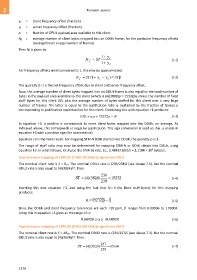Page 1286 - 5G Basics - Core Network Aspects
P. 1286
2 Transport aspects
yc = client frequency offset (fraction)
ys = server frequency offset (fraction)
p = fraction of OPUk payload area available to this client
Nf = average number of client bytes mapped into an ODUk frame, for the particular frequency offsets
(averaged over a large number of frames)
Then Nf is given by:
1 y c
N ST (I-1)
f
1 y s
For frequency offsets small compared to 1, this may be approximated:
N f ST 1( y c y ) ST (I-2)
s
The quantity –1 is the net frequency offset due to client and server frequency offset.
Now, the average number of client bytes mapped into an ODUk frame is also equal to the total number of
bytes in the payload area available to this client (which is (4)(3808)p = 15232p), minus the number of fixed
stuff bytes for this client (N), plus the average number of bytes stuffed for this client over a very large
number of frames. The latter is equal to the justification ratio multiplied by the fraction of frames p
corresponding to justification opportunities for this client. Combining this with equation I-1 produces:
ST 15232 N (I-3)
In equation I-3, a positive corresponds to more client bytes mapped into the ODUk, on average. As
indicated above, this corresponds to negative justification. This sign convention is used so that enters in
equation I-3 with a positive sign (for convenience).
Equation I-3 is the main result. For mapping STM-N (CBR clients) into ODUk, the quantity p is 1.
The range of stuff ratio may now be determined for mapping STM-N or ODUj clients into ODUk, using
8
equation I-3. In what follows, let R16 be the STM-16 rate, i.e., 2.48832 Gbit/s = 3.1104 10 bytes/s.
Asynchronous mapping of CBR2G5 (2 488 320 kbit/s) signal into ODU1
The nominal client rate is S = R16. The nominal ODU1 rate is (239/238)S (see clause 7.3). But the nominal
ODU1 rate is also equal to (4)(3824)/T. Then:
238
ST 4 ( )( 3824 ) 15232 (I-4)
239
Inserting this into equation I-3, and using the fact that N = 0 (no fixed stuff bytes) for this mapping
produces:
15232 1
(I-5)
Since the ODUk and client frequency tolerances are each 20 ppm, ranges from 0.99996 to 1.00004.
Using this in equation I-5 gives as the range of :
. 0 60928 . 0 60928 (I-6)
Asynchronous mapping of CBR10G (9 953 280 kbit/s) signal into ODU2
The nominal client rate is S = 4R16. The nominal ODU2 rate is (239/237)S (see clause 7.3). But the nominal
ODU2 rate is also equal to (4)(3824)/T. Then:
237
ST 4 ( )( 3824 ) 15168 (I-7)
239
1276

